Community projects rely on local doctors for larger success
More than 40 million American adults don't receive health-related services.
More than 40 million American adults don't receive health-related services, mostly because they don't have health insurance or they fail to understand how to navigate the health care system, according to figures released late last year by the CDC. Successful programs working with this population often rely on volunteer physicians and specialists not only to provide care but often to guide patients through the process.
The New York-based Commonwealth Fund looked at the attributes of long-running community access initiatives: strong leadership, ongoing funding, outcomes evaluations and physician participation.
“Each of these programs had some component of physician volunteerism,” said Karen Minyard, PhD, director of the Georgia Health Policy Center at Georgia State University, Atlanta, who headed the study. While many physicians are concerned about the uninsured, most find it difficult to step up and single-handedly take on this issue.
“You would get bombarded with all the uninsured patients and it would overwhelm your practice and you'd go out of business,” she said. “Physicians I've talked to about this really want to be able to give. There often just isn't a structure that allows them to do it.”
However, she continued, if a community structure lets physicians as well as hospitals, local agencies and even drug companies chip in then it fosters an environment that makes physicians feel like they can contribute, Dr. Minyard said.
Physician leadership
In Wichita, Kan., where the Medical Society of Sedgwick County helped create Project Access in 1999, physicians really feel ownership of the program, said Anne Nelson, the associate executive director of the Central Plains Regional Healthcare Foundation, which manages the program.
Project Access, modeled after an Asheville, N.C. program, offers adults without health coverage who meet income, residential, and uninsured criteria six months of donated primary care or three months of donated specialty care. These periods can be extended when appropriate.
Currently, 163 primary care and 409 specialty physicians donate their services. One volunteer, Ha Ta, MD, an internist who practices at the University of Kansas School of Medicine residency program in Wichita, noted that many of the patients she sees through Project Access initially have severe medical problems.

“They are either not savvy about the medical system or they haven't been exposed to it,” she said. “When they present to me, they are very sick. I have to get them care somewhere.”
Under Project Access, services donated through participating hospitals and labs, patients obtain important services that they otherwise might not have been able to afford, such as sleep studies, liver biopsies or CAT scans, said Dr. Ta. Approximately $18 million in donated physician services have been provided. However, the average cost per patient has been decreasing because of better coordinated care, according to the Commonwealth study.
Primary care services are aimed at getting patients back on their feet and perhaps re-entering the job market, where they can obtain insurance. Or, patients can be directed toward Medicaid or Medicare coverage. They also get assistance on reduced cost or free medications through a generic prescription program funded by city and county funds or from pharmaceutical companies.
More than 7,700 individuals have enrolled in Project Access, with about 300 remaining enrolled across several years. “I [try to] get their disease treated or stabilized, or otherwise they get shuffled around,” Dr. Ta said. She also works to educate her patients to the point that they can understand their conditions, the medical terms being used and the medications they are taking.
“If you don't take care of these patients right now, they're going to come back sicker. It's going to cost the medical community more. It's going to cost all of us eventually,” she said. “What we're trying to do right now … is help stymie that and just pay it forward.”

Project Access also has helped filling subspecialist referrals, said S. Edwards Dismuke, FACP, dean and professor at the University of Kansas School of Medicine in Wichita.
Nearly three-fourths of the local medical society members who are specialists have agreed to provide services to at least 10 Project Access patients per year, said Dr. Dismuke, a former Project Access board member. This dispelled fears by some specialists that they would be overwhelmed with requests.
Demonstrating community value
Freddy Gaton, MD, runs a busy family practice in rural Roberta, Ga., which includes nearly 100 patients enrolled through the Community Health Works (CHW) of Georgia program. A collaboration of area hospitals, county and local governments, and health care providers and clinics started the program in 2001 to assist uninsured patients in the seven-county area of central Georgia with an 18% uninsured rate.
The CHW program, headquartered in Forsyth, Ga., focuses on chronic conditions such as diabetes, depression, hypertension, cardiovascular disease and cancer. CHW, like the Wichita-based Project Access, got its start through various foundation grants, federal and local grants, and commitments from providers to give free care for eligible uninsured patients.
The number of uninsured patients that Dr. Gaton sees, he admitted, “is a drop in the bucket.” He does not charge those patients or limit his patient panel. Enrollees on average have three diseases and use about five medications.
Many of his patients probably would have neglected care and eventually presented in the hospital's emergency room, said Dr. Gaton, who is also a CHW board member. “By then it's a drain for them, and financially it's a drain on the community that has to pay for that.”
Treating patients earlier resulted in a 45% lower hospitalization rate when compared with non-CHW members with chronic conditions, said Gregory Dent, CEO of Georgia CHW. Emergency room use is 15% lower.
Also, patients with chronic conditions are becoming better at treating their conditions by obtaining needed medications at no or low cost through a CHW pharmaceutical assistance program that coordinates with pharmaceutical manufacturers. “A lot of our members [previously] had lacked the confidence or the capacity to navigate the system,” Mr. Dent said. “Now we just provide that help that they need.”
Coordinating resources
CHOICE Regional Healthcare Network, headquartered in Olympia, Wash., has used a multifaceted approach to providing medical assistance to the uninsured since 1995. It was founded by and continues to receive core financial support from seven hospitals and five counties in western Washington State.
One facet of CHOICE's work is community development to help create and sustain new services and better link existing services. An example is Thurston County Project Access, a program that provides primary care assistance for six months to uninsured with incomes below 250% of the federal poverty level. Thurston County Project Access now operates independently under physician leadership.
Kevin Haughton, MD, director of the Providence St. Peter Family Medicine Residency Program in Olympia and a CHOICE board member, said the program works well from the physician point of view. “I think [physicians] like participating in a fashion that doesn't swallow them up so their whole life becomes doing this stuff.”
One obstacle facing the program is the shortage of primary care physicians available for all patients in the five-county region. Project Access has had to limit its points of referral into the program to three primary care access points—Dr. Haughton's family residency program, a community health center, and a neighborhood free medical clinic.
Aside from health issues, CHOICE also screens for other life-related issues among the uninsured. “What we find is that about 10% of the people we touch have serious and complex needs beyond health care that are impacting their health,” said Kristen West, CHOICE's executive director. These can include problems with food and housing, mental health, substance abuse or language interpreter services.
But the main goal remains assisting patients to not only navigate the system but know “what are the right questions to ask and how to understand the data they're getting from various perspectives,” Ms. West said. It's part of the way to move people from what she calls “the chronic crisis state” to a “more stable place.”
Sustainability challenges
Overall, what works for one community may not work in another, Dr. Minyard emphasized. For instance, one Arkansas program profiled in the Commonwealth Fund study later failed because “The physicians and the leaders of the program were not in sync.”
“The sustainability of the work is hard,” she said. Programs that succeed have found ways to connect the resources to what they are doing, get participants to buy in and recognize the value of what they are doing, and demonstrate the value of the work being done.
“And, the programs that have physician leadership as a strong component tend to have more success,” she said.





